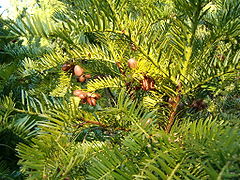Cephalotaxus
| Cephalotaxus | |
|---|---|

| |
| Cephalotaxus harringtonia | |
| Scientific classification | |
| Kingdom: | |
| Division: | |
| Class: | |
| Order: | |
| Family: | |
| Genus: | Cephalotaxus |
| Species | |
|
Cephalotaxus fortunei | |
Cephalotaxus, commonly called plum yew or cowtail pine, is a genus of conifers comprising 11 species, treated in either the Cephalotaxaceae, or in the Taxaceae when that family is considered in a broad sense.[1][2] The genus is endemic to eastern Asia, though fossil evidence shows it had a wider Northern Hemisphere distribution in the past.[1] The species are evergreen shrubs and small trees reaching 1.0–10 m (rarely to 20 m) tall.
Description
The leaves are spirally arranged on the shoots, but twisted at the base to lie in two flat ranks (except on erect leading shoots); they are linear, 4–12 cm long and 3–4 mm broad, soft in texture, with a blunt tip; this helps distinguish them from the related genus Torreya, which has spine-tipped leaves.[2]
The species can be either monoecious or dioecious; when monoecious, the male and female cones are often on different branches. The male (pollen) cones are 5–8 mm long, grouped in lines along the underside of a shoot. The female (seed) cones are single or grouped two to 15 together on short stems; minute at first, they mature in about 18 months to a drupe-like structure with the single large nut-like seed 1.5–4 cm long surrounded by a fleshy covering, green to purple at full maturity. Natural dispersal is thought to be aided by squirrels which bury the seeds for a winter food source; any seeds left uneaten are then able to germinate.[2]
